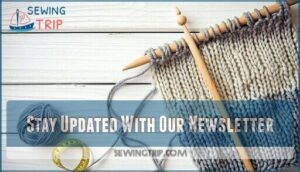This site is supported by our readers. We may earn a commission, at no cost to you, if you purchase through links.

You’ll soak your pieces in lukewarm water, gently squeeze out excess moisture, then pin them to measurements on blocking mats or towels until completely dry.
This simple step prevents the frustration of trying to match wonky edges and guarantees your seams lie flat instead of puckering like a grumpy accordion, which is a game-changing technique that sets you up for assembly success.
The magic happens overnight while your knitting relaxes into its intended shape, making you wonder why anyone skips this simple step.
Table Of Contents
Key Takeaways
- Soak your knitted pieces in lukewarm water for 10-30 minutes to relax fibers before pinning them to exact pattern measurements on blocking mats
- Choose the right blocking method for your yarn type – wet blocking works best for wool, while steam blocking suits synthetic fibers and delivers faster results
- Block each piece completely before assembly to ensure perfect stitch alignment, prevent puckering, and create professional-looking seams that lie flat
- Allow 1-3 days for complete drying before removing pins or starting construction, as rushing this step compromises the shape-setting benefits of blocking
What is Blocking in Knitting?
Ever wondered why your beautiful knitting looks amateur despite perfect stitches?
Blocking knitting transforms your handwork from homemade to professional by stretching and shaping finished pieces to match pattern dimensions.
Transform your knitting from homemade to handcrafted masterpiece with this essential finishing technique.
This knitwear finishing technique smooths uneven stitches, opens lace patterns, and sets your project’s final shape.
Different fiber types respond uniquely—wool loves wet blocking while synthetics need gentler methods.
Blocking before sewing prevents common beginner mistakes like mismatched seams and puckering, and it’s the secret step that separates exceptional knitters from the rest, making your project look truly professional with perfect stitches.
Types of Blocking Tools
Beyond building your blocking arsenal, you’ll need specific tools to transform your knitted pieces into professional-looking garments.
Your blocking toolkit should include these essential items:
- Blocking mats with grid lines for accurate measurements and shape alignment
- Rust-resistant T-pins to secure edges without leaving marks on your knits
- Blocking wires for creating crisp, straight edges on shawls and large pieces
- Sock blockers that maintain perfect sock shape without requiring pins
- KnitIQ blocking board systems for portable, durable blocking surfaces
These blocking tools work together to give you complete control over your project’s final dimensions and appearance.
Consider the benefits of using mats for professional results.
The Process of Wet Blocking
Once you’ve gathered your blocking tools, it’s time to start the wet blocking process.
Begin by soaking your knitted piece in lukewarm water for 10-30 minutes – this soaking duration allows fibers to fully relax. Water temperature matters; too hot can damage delicate yarns.
Gently press out excess water without wringing. Lay the damp piece on your blocking mats as your drying surface, then use pinning techniques to shape it to pattern measurements.
Using specialized drying products can improve the blocking process. Consider fiber considerations – wool responds beautifully, while synthetic blends need gentler handling.
Spray Blocking: an Alternative Method
Looking at spray blocking as your go-to blocking technique, you’ll find it perfect for targeted shaping without oversaturating your work.
This portable blocking method gives you moisture control while protecting delicate fibers from harsh soaking. You can find the necessary supplies here.
Benefits of Spray Blocking:
- Quick corrections – Make fine adjustments on specific areas without waiting hours
- Gentle treatment – Your intricate lace patterns won’t get flattened or distorted
- Perfect control – Target exactly where you need reshaping without overdoing it
- Time-saver – Skip the soaking step and get straight to sewing up knitting
Simply mist your blocked piece lightly, shape to measurements, and let air dry completely before assembly.
Steam Blocking for Effective Results
Steam blocking transforms your knitting game with speed and precision. Unlike wet blocking’s lengthy soaking time, steam works fast—perfect when you’re anxious to finish.
You’ll target problem areas like curling edges or stubborn cables with pinpoint accuracy. Animal fibers like wool and alpaca respond beautifully to steam’s gentle heat, relaxing into perfect shape.
Grab rust-proof pins to secure pieces while steaming. This technique gives you complete control over blocking before sewing, ensuring professional seams every time.
Benefits of Blocking Before Seaming
You’ll want to block your knitted pieces before sewing them together to guarantee professional-looking results.
Blocking before seaming is your secret weapon for professional-looking knits that fit perfectly.
This simple step aligns your stitches perfectly and prevents the frustration of uneven seams or mismatched measurements. Complete concepts and separate lines.
Importance of Blocking
Blocking transforms your knitted pieces from rough drafts into polished masterpieces.
When you block knitting before seaming, you’re setting yourself up for success with these key benefits:
- Fabric Enhancement – smooths uneven stitches and relaxes yarn tension
- Shape Retention – maintains proper garment dimensions throughout wear
- Professional Finish – elevates homemade pieces to store-bought quality
- Dimensional Accuracy – guarantees pattern measurements match your finished work
- Texture Improvement – opens lace patterns and defines cable details
These benefits work together to enhance the overall quality of your knitted pieces, making them look more professional and ensuring they retain their shape and texture over time.
Better Stitch Alignment
When you block before sewing, your stitches align like puzzle pieces finding their perfect match.
Blocking creates even edges and consistent tension throughout each piece, making seam matching effortless.
You’ll prevent distortion that often occurs during garment assembly, ensuring better stitch alignment from start to finish, with a professional finish every time, due to this simple step that delivers a consistent tension.
Improved Finished Appearance
Your project transforms from homemade to handcrafted masterpiece when you block before sewing.
Professional Handknits emerge through Enhanced Stitch Definition that makes every loop crisp and purposeful.
Reduced Fabric Curling eliminates those stubborn edges that fight your seams, while Evened Fabric Changes prevent awkward puckering where ribbing meets stockinette.
For a clean, couture finish, consider Hong Kong seams.
Garment Shape Accuracy guarantees your sweater actually fits like the pattern promised—no more wonky shoulders or twisted hems ruining months of work.
Stay Updated With Our Newsletter
Newsletter subscriptions reveal your creative potential with exclusive content, knitting updates, and special offers delivered straight to your inbox.
You’ll gain community access to fellow crafters sharing knitting blocking techniques and garment construction tips.
Discover project sneak-peeks, master blocking before seaming methods, and elevate your seam finishing skills.
Join thousands who’ve transformed their knitting through expert guidance and inspiration.
Frequently Asked Questions (FAQs)
Do you block knitting before sewing together?
Like a well-rehearsed dance, you’ll want to block your knitting pieces before sewing them together.
This technique guarantees your stitches align perfectly, edges lie flat, and measurements match your pattern’s specifications for professional-looking results, ensuring that your stitches are properly aligned.
Do you block knitting in hot or cold water?
You’ll want to use cool water for blocking your knitted pieces.
Hot water can shock natural fibers like wool, causing them to felt or shrink unexpectedly.
Cool water gently relaxes the fibers, allowing you to reshape your work without damaging it.
This temperature keeps your stitches looking their best.
Can you block acrylic or synthetic yarn projects?
Notably, you can’t traditionally block acrylic yarn since it doesn’t respond like natural fibers.
Instead, you’ll use "killing" – applying heat with a steam iron to relax synthetic fibers permanently.
This technique sets the shape but can’t be undone, as it is a form of permanent alteration, often referred to as "killing" the fibers.
How long should knitted pieces dry after blocking?
Your knitted pieces need 1-3 days to dry completely after blocking, depending on humidity and thickness. Don’t rush it—fully dried pieces hold their shape better and won’t develop mildew.
What temperature water works best for wet blocking?
Cool water works best for wet blocking—around room temperature or slightly cooler.
Hot water can shock natural fibers like wool, causing them to felt or shrink permanently, ruining your project.
Should you block ribbing or garter stitch sections?
You should absolutely block ribbing and garter stitch sections.
These areas can curl, pucker, or appear uneven without blocking.
The process relaxes fibers and creates smoother, more professional-looking edges that’ll sew together beautifully, with complete concepts of fiber relaxation and edge smoothing being key to the blocking process.
Can blocking fix uneven tension in knitting?
Yes, blocking can substantially improve uneven tension by relaxing fibers and evening out stitches.
The moisture and shaping process helps redistribute yarn, smoothing tight or loose areas for a more consistent fabric appearance, which also involves evening out stitches.
Conclusion
Research confirms that blocking creates measurably flatter, more uniform knitted pieces compared to unblocked work.
When you learn how to block knitting before sewing up, you’re investing in professional-quality results that make assembly effortless.
Your patience during the drying process pays off with perfectly aligned stitches and seams that won’t buckle or pucker.
This essential technique transforms amateur-looking projects into polished, store-bought quality pieces, making a dramatic difference.
You’ll never skip blocking again once you see the difference it makes.










